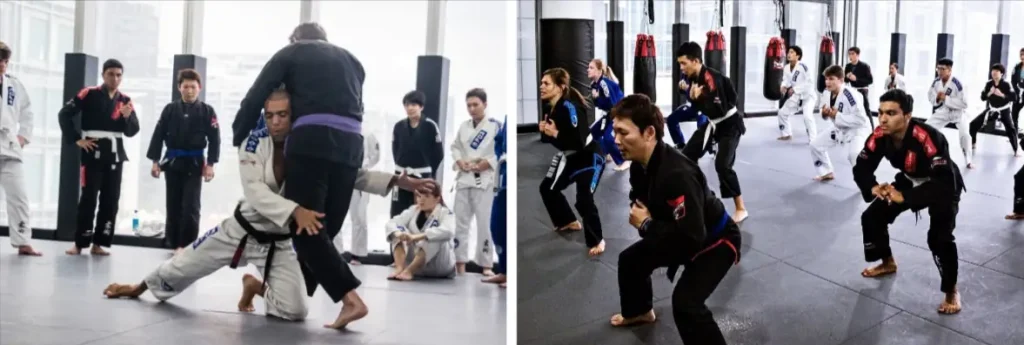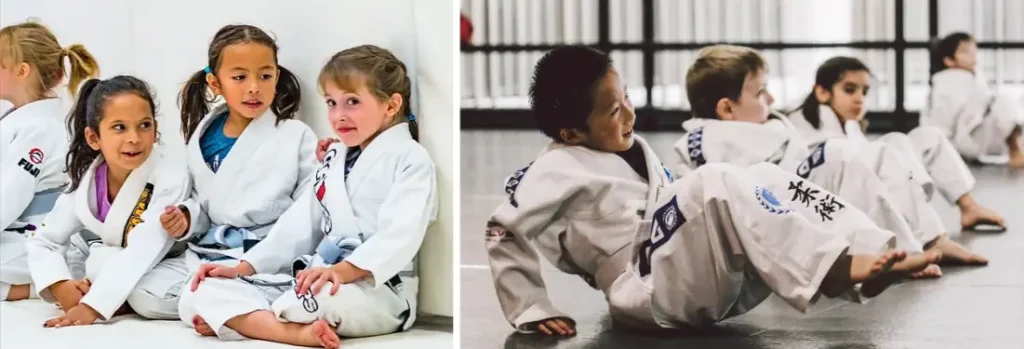How To Structure BJJ Class [Tips and Advice]
If you’re new to the world of Brazilian jiu jitsu, you might be wondering about the intricacies of BJJ classes structure. BJJ is more than just a martial art; it’s a discipline that requires a well-organized approach to learning and training.
In this comprehensive guide, we will delve into the strategy, preparation, and structure of BJJ classes, ensuring you have the tools to make the most out of your journey on the mats.
What is the Strategy of BJJ?
BJJ is often compared to a game of chess.
It’s a martial art that focuses on ground fighting, where practitioners aim to submit their opponents through the application of various techniques. The strategy in BJJ involves not only physical strength and agility but also mental acuity and tactical thinking.
In a BJJ class, the primary goal is to teach students how to effectively use leverage, technique, and positioning to overcome larger and stronger opponents.
It’s a martial art that emphasizes technique over brute force, making it accessible to people of all sizes and physical abilities.
How Do I Prepare for a BJJ Class?
Before diving into the specifics of BJJ classes structure, it’s essential to understand how to prepare for a class properly.
Here are some tips to ensure you make the most out of your training sessions:
- Gear Up: Ensure you have the right gear, including a BJJ gi (uniform), mouthguard, and appropriate clothing. Comfort and safety are paramount.
- Hydrate and Eat: Stay hydrated before class and have a light meal or snack a couple of hours before training. You’ll need the energy.
- Stretch and Warm-Up: Arrive early to stretch and warm up. BJJ can be physically demanding, so preparing your body is crucial.
- Mental Preparation: Clear your mind and focus on the class ahead. Leave any distractions or stress outside the gym.
What is BJJ Fundamentals Class?
BJJ fundamentals classes are the backbone of any BJJ academy. These classes are designed for beginners and serve as the entry point into the world of Brazilian jiu jitsu. The focus is on teaching the foundational techniques, positions, and concepts that form the basis of BJJ.
In a fundamentals class, you can expect to learn basic positions like mount, guard, and side control, as well as fundamental submissions and escapes.
These classes are essential for building a strong BJJ foundation, and even experienced practitioners revisit them regularly to refine their skills.
What Is the Structure of the BJJ Practice?
Now, let’s dive into the heart of the matter – the structure of a typical BJJ class. BJJ classes are usually organized into several segments, each with a specific purpose:
Warm-Up
A BJJ class typically begins with a warm-up session. This can include a combination of jogging, calisthenics, and specific BJJ movements. The warm-up serves to prepare your body for the physical demands of training and helps prevent injuries.
Technique Instruction
After the warm-up, the instructor will demonstrate and explain the techniques that will be covered in that class. This is a crucial part of the class where you’ll learn the moves, grips, and positions used in BJJ.
Drilling
Following the technique instruction, students pair up to practice the techniques. During this drilling phase, you’ll take turns as the person applying the technique (the “top” position) and the person defending (the “bottom” position). This repetition helps you understand and internalize the moves.
Sparring (Rolling)
Sparring, often referred to as “rolling,” is where you apply what you’ve learned in a live, resistance-based situation. This is the closest simulation to a real fight in a controlled environment. It allows you to test your skills and adapt to different opponents.
Cool-Down
The class typically ends with a cool-down session, which involves stretching and relaxation exercises. This helps prevent muscle soreness and aids in recovery.
How Long Should a Typical BJJ Class Last?
The duration of a BJJ class can vary from one academy to another, but they usually last around 90 minutes to 2 hours. This duration includes the warm-up, technique instruction, drilling, sparring, and cool-down. Some academies might offer shorter classes for beginners to gradually build their stamina and familiarity with the sport.
How Do I Schedule My BJJ Training?
Scheduling your BJJ training depends on your goals and availability.
Many academies offer morning and evening classes to accommodate different schedules. It’s essential to be consistent with your training, as regular practice is key to progress in BJJ.
Consider your personal fitness level and commitments when deciding how often to train. Starting with 2-3 classes per week is a good foundation, and you can increase the frequency as you become more comfortable and experienced.
What Should Be Included in a BJJ Class Warm-up?
A proper warm-up in a BJJ class is crucial to prevent injuries and prepare your body for the physical demands of training. Here’s what you can expect in a BJJ warm-up:
- Light Jogging: A few minutes of jogging in place or around the mat to increase your heart rate.
- Dynamic Stretches: Exercises like leg swings, arm circles, and hip rotations to loosen up your joints.
- Calisthenics: Bodyweight exercises such as rollovers, push-ups, squats, and burpees to further warm up your muscles.
- Specific BJJ Movements: Warm-up drills that mimic BJJ movements, like shrimping and bridging.
A well-structured warm-up should last around 15-20 minutes and gradually increase in intensity.

How to Structure Techniques in a BJJ Class?
The structure of techniques in a BJJ class often follows a logical progression.
Instructors typically start with basic techniques and gradually build upon them throughout the class. Here’s a breakdown of how techniques are structured:
- Fundamental Techniques: Beginners start with fundamental techniques that are easy to understand and execute, such as basic sweeps and submissions.
- Positional Drills: Students often engage in positional drills where they focus on a specific aspect of a position or technique, such as maintaining guard or escaping from side control.
- Technique Chains: Instructors might teach a series of techniques that flow seamlessly from one to another. This helps students understand how to transition between moves in a real sparring situation.
- Advanced Techniques: As students progress, more advanced techniques and strategies are introduced.
- Live Drilling: Techniques are practiced in a live, drilling setting, allowing students to apply what they’ve learned with resistance.
How to Balance Drilling and Sparring in BJJ Classes?
Finding the right balance between drilling and sparring is essential for effective BJJ training. Too much drilling can lead to robotic movements, while too much sparring without drilling can result in a lack of technique.
BJJ classes typically strike this balance by incorporating both elements:
- Technique-Focused Classes: Some classes are primarily dedicated to drilling and refining techniques. These classes are crucial for building a strong technical foundation.
- Sparring Sessions: Sparring, rolling, or open mat sessions allow students to practice techniques in a live, dynamic environment. It’s where you test your skills and adapt to different opponents.
In most BJJ academies, you’ll find a mix of both types of classes throughout the week, ensuring a well-rounded training experience.
What Are Some Effective Teaching Methods for BJJ Classes?
Effective teaching methods are essential for a productive BJJ class. Instructors use various techniques to convey information and help students learn.
Here are some effective teaching methods commonly used in BJJ classes:
- Demonstration: Instructors demonstrate techniques, showing proper form and execution.
- Visualization: Encouraging students to visualize themselves performing techniques correctly can enhance learning.
- Feedback: Providing feedback and corrections during drilling and sparring sessions helps students improve.
- Progressive Teaching: Starting with simple techniques and gradually increasing complexity ensures students build a solid foundation.
- Question and Answer: Instructors often encourage students to ask questions to clarify doubts and deepen their understanding.
How to Structure BJJ Class Reddit Recommendations
Reddit can be a valuable resource for BJJ practitioners looking for advice on structuring classes. Here are some recommendations from the BJJ community on Reddit:
| Element of Class Structure | Description |
|---|---|
| Warm-Up | Varies from no warm-up to warm-ups involving running, shrimping, and BJJ-specific movements. Typically 5-20 minutes. |
| Technique Presentation | Typically includes presenting 3-4 BJJ techniques. |
| Drilling | Involves drilling the techniques presented, often for 20-30 minutes. |
| Positional Drilling | Some classes incorporate positional drills to work on specific positions and situations. |
| Sparring/Rolling | Sparring sessions range from 5-30 minutes, with some classes having light rolling for beginners and more extensive rolling for advanced students. |
| Cool Down and Stretching | Some classes include cool-down and stretching at the end, usually lasting 5-10 minutes. |
| Class Structure Component | Key Points |
|---|---|
| Warm-Up | – Varies from no warm-up to 10-15 minutes of light warm-up. Some prefer dynamic stretching, while others like light rolling as a warm-up. |
| Technique Instruction | – Typically involves teaching 2-3 techniques. – Duration ranges from 10-30 minutes. – Techniques are often related to a specific position or theme. |
| Drilling | – After technique instruction, students drill the techniques learned. – Drilling time can vary from 10-20 minutes. |
| Positional Sparring | – Positional sparring sessions are common, usually lasting around 20-45 minutes. – Positional sparring focuses on the techniques learned during the class. |
| Rolling (Sparring) | – Live rolling typically follows positional sparring. – Rolling sessions can last 5-10 minutes per round. – The number of rounds varies based on belt level. |
| Class Duration | – Class duration varies but generally ranges from 1 to 1.5 hours. |
| Curriculum (for White Belts) | – Some schools have a structured curriculum for white belts. |
| Customized Training (for Advanced) | – Advanced students may have the flexibility to work on their chosen techniques. – Instructors and peers provide advice and guidance. |
- Listen to Your Body: Pay attention to your body’s signals during training. If you’re exhausted or injured, it’s okay to take a break.
- Focus on Fundamentals: Many Redditors emphasize the importance of fundamentals classes for all levels, as they provide a strong base for more advanced techniques.
- Communicate with Instructors: If you have specific goals or concerns, don’t hesitate to talk to your instructors. They can provide guidance tailored to your needs.
- Consistency Matters: Consistency in training is more important than intensity. Regular, consistent practice yields better results than sporadic, intense training.
- Enjoy the Journey: BJJ is a long-term endeavor. Enjoy the process of learning and improving, and don’t be discouraged by setbacks.
How to Structure BJJ Class for Beginners Step by Step
If you’re a beginner, here’s a step-by-step guide on how to structure your BJJ class experience:
- Warm-Up: Arrive early and participate in the warm-up to prepare your body.
- Technique Instruction: Pay close attention during the technique instruction portion, as this is where you learn the moves.
- Drilling: Pair up with a partner to practice the techniques. Start slow and focus on correct form.
- Sparring: As a beginner, start with light, controlled sparring to get a feel for applying techniques in a live situation.
- Cool-Down: Participate in the cool-down to aid in recovery.
- Ask Questions: Don’t hesitate to ask questions if you’re unsure about anything. Instructors and fellow students are usually happy to help.
Should BJJ Classes Be Split by Skill Level or Open to All?
Whether BJJ classes should be split by skill level or open to all depends on the academy’s approach and the goals of the class. Here are some considerations:
- Beginner-Focused Classes: Many academies offer classes specifically designed for beginners. These classes provide a safe and supportive environment for newcomers to learn the basics.
- Mixed-Level Classes: Some academies prefer mixed-level classes, where practitioners of all skill levels train together. This can be beneficial as beginners can learn from more experienced students.
- Advanced Classes: Advanced classes are often reserved for higher-level practitioners who want to focus on more complex techniques and sparring.
Ultimately, the choice depends on your goals and comfort level. Beginners may initially benefit from beginner-focused classes to build confidence before joining mixed-level sessions.
What Safety Measures Should Be Implemented in BJJ Classes?
Safety is paramount in BJJ, and academies take several measures to ensure the well-being of their students:
- Hygiene and Cleanliness: Mats and equipment should be clean and sanitized regularly to prevent infections.
- Injury Prevention: Instructors emphasize proper techniques to minimize the risk of injuries.
- Tap Early: In sparring, practitioners are encouraged to tap out when they feel discomfort or submission is imminent to avoid injury.
- Supervision: Instructors closely supervise sparring sessions to ensure safety.
- Respect: Students are expected to respect their training partners and train in a controlled and safe manner.
How Do I Get the Most Out of My BJJ Class?
Getting the most out of your BJJ class requires dedication and the right mindset. Here are some tips to maximize your learning and progress:
- Stay Consistent: Regular attendance is crucial for improvement.
- Focus on Fundamentals: Master the basics before moving on to advanced techniques.
- Ask Questions: Don’t be afraid to seek clarification from your instructors or training partners.
- Record Your Progress: Keep a training journal to track your progress and areas for improvement.
- Stay Humble: BJJ is a humbling martial art. Embrace the learning process and be open to feedback.
How to Keep BJJ Classes Engaging and Fun?
Keeping BJJ classes engaging and fun is essential to maintain motivation. Here are some ways to make your classes enjoyable:
- Variety: Mix up the techniques and drills to keep things interesting.
- Competitions: Organize friendly in-house competitions or roll-offs to create a competitive yet fun atmosphere.
- Open Mat Sessions: Many academies offer open mat sessions where you can spar and experiment with techniques independently.
- Socialize: Build friendships with your training partners and enjoy the camaraderie of the BJJ community.
- Set Goals: Set achievable goals for yourself, whether it’s earning your next belt or mastering a specific technique.
How to Adapt BJJ Classes for Kids vs. Adults?
BJJ classes for kids and adults differ in their approach due to varying physical abilities and attention spans. Here’s how classes are adapted for each group:
BJJ Classes for Kids:
- Shorter Duration: Kids’ classes are typically shorter to match their attention spans.
- Games and Drills: Instructors use games and fun drills to teach techniques and keep kids engaged.
- Emphasis on Discipline: BJJ teaches discipline and respect, and these values are emphasized in kids’ classes.
- Promotions: Kids often have a separate belt system with different criteria for promotions.
BJJ Classes for Adults:
- Longer Duration: Adult classes are generally longer and offer more in-depth training.
- Structured Curriculum: Adult classes follow a structured curriculum that covers a broader range of techniques.
- Sparring: Adult classes include more sparring to simulate real situations.
- Belt System: Adults typically follow the traditional belt system, starting with white and progressing to black belts.

What Is the Role of Sparring in BJJ Classes?
Sparring, also known as rolling, is a crucial component of BJJ classes. It serves several purposes:
- Application of Techniques: Sparring allows you to apply the techniques you’ve learned in a live, dynamic situation.
- Testing Your Skills: It’s a way to test your skills against resisting opponents, helping you identify areas for improvement.
- Adaptation: Sparring teaches you how to adapt to different styles and strategies.
- Mental Toughness: It builds mental toughness and helps you stay calm under pressure.
- Fun and Enjoyment: Many practitioners find sparring to be the most enjoyable part of BJJ.
How to Evaluate Progress in Jiu Jitsu Classes?
Evaluating progress in BJJ can be subjective, but there are several indicators to consider:
- Belt Promotions: Advancing to a higher belt is a clear sign of progress.
- Technique Mastery: The ability to execute techniques with precision and control.
- Performance in Sparring: Improved performance and successful submissions in sparring indicate progress.
- Increased Confidence: As you become more skilled, you’ll gain confidence in your abilities.
- Competitions: Success in BJJ competitions can also reflect progress.
In conclusion, the structure of BJJ classes is a well-thought-out process that combines warm-up, technique instruction, drilling, sparring, and cool-down. Whether you’re a beginner or an experienced practitioner, understanding and adhering to this structure will help you make the most of your BJJ journey. Stay consistent, stay safe, and enjoy the rewarding path of Brazilian jiu jitsu.
